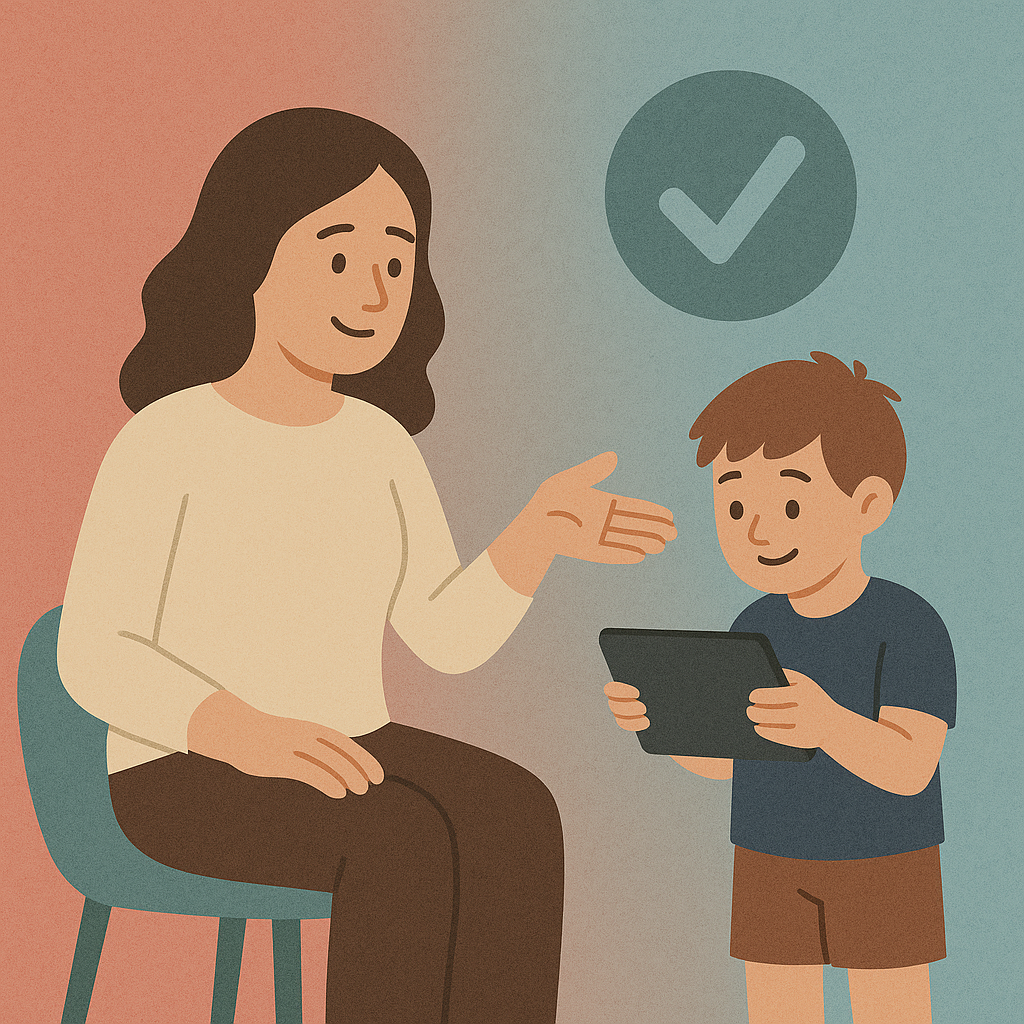Navigating Social Media
&
Screen Time Together
You're not alone in feeling overwhelmed by your child's screen time. In today's digital world, finding balance is one of the biggest parenting challenges. We're here to help you create healthy boundaries while maintaining connection with your child.

The Reality of Screen Time Today
What's Normal? Age-Based Guidelines
Healthy Boundaries
- No phones during family meals
- Devices charge outside bedrooms
- 1 hour before bed = screen-free
Focus Areas
- • Self-regulation skills
- • Digital wellness conversations
- • Cyberbullying prevention
- • Healthy relationship modeling
Making Screen Time Meaningful Together
Screen time doesn't have to be something to just limit—it can be an opportunity for connection, learning, and fun when approached thoughtfully. Here are ways to transform screen time into quality time.
- Watch documentaries together and discuss what you learned
- Pause shows to ask "What do you think will happen next?"
- Create family movie nights with themed snacks
- Watch age-appropriate TED Talks and share thoughts
- Follow along with cooking or art tutorials together
- Take virtual museum tours or nature webcam visits
- Learn a new language together with apps
- Create digital photo albums or family videos
- Play cooperative puzzle games that require teamwork
- Try motion-controlled games for physical activity
- Build virtual worlds together in creative games
- Play educational trivia or word games as a family
- Practice guided meditation or mindfulness apps together
- Use fitness apps for family workout sessions
- Track family goals together (steps, reading, etc.)
- Explore nature identification apps during outdoor walks
- Video call with distant family members together
- Create digital scrapbooks of family memories
- Share and discuss interesting articles or videos
- Plan family trips using travel apps and virtual tours
- Code simple programs or animations together
- Explore science experiments through educational videos
- Use astronomy apps to identify stars and planets
- Solve logic puzzles and brain teasers as a team
Before Screen Time:
- Set a clear time limit and stick to it
- Choose content together based on shared interests
- Ensure other responsibilities are completed first
- Create a comfortable, distraction-free environment
During Screen Time:
- Engage actively - ask questions and share observations
- Pause to discuss interesting or confusing parts
- Model good digital citizenship and critical thinking
- Take breaks for physical movement or eye rest
After Screen Time:
Transition mindfully by discussing what you experienced together. Ask questions like "What was your favorite part?" or "What did that make you think about?" This helps process the content and strengthens your connection while building critical thinking skills.
Age-Specific Co-Screen Time Ideas
- • Sing-along videos with actions
- • Simple counting or letter games
- • Virtual zoo or aquarium visits
- • Story time apps with interactive elements
- • Basic drawing or coloring apps
- • Educational documentaries with discussions
- • Coding games and simple programming
- • Virtual field trips to historical sites
- • Collaborative building games
- • Science experiment videos to try together
- • TED Talks on topics of mutual interest
- • Strategy games that require teamwork
- • Learning new skills through online courses
- • Creating content together (videos, podcasts)
- • Exploring career interests through virtual experiences
- • Watching documentaries and debating topics
- • Learning new languages or skills together
- • Virtual travel planning and exploration
- • Collaborative creative projects
- • Staying connected through shared digital interests
Conversation Scripts
Opening:
"I've been thinking about social media and how it affects our family. I'd love to hear your thoughts and work together on some guidelines that feel fair to both of us."
Exploring their perspective:
"What do you enjoy most about [platform]? Are there any parts that stress you out or make you feel bad?"
Setting boundaries together:
"Let's create some family agreements that help everyone feel good about screen time. What ideas do you have?"
When gaming interferes with responsibilities:
"I notice gaming has been taking priority over [homework/chores/sleep]. Let's problem-solve this together. What would help you balance both?"
Addressing mood changes:
"I've noticed you seem [frustrated/angry] when gaming time ends. That must be really hard. Can we talk about what makes it difficult to stop?"
Collaborative solutions:
"What if we set up a timer system where you get a 10-minute warning before gaming time ends? Would that help with the transition?"
Setting Healthy Boundaries Without Power Struggles
Effective boundaries aren't about control or punishment—they're about creating structure that helps everyone feel safe and respected. Here's how to set limits that actually work without damaging your relationship.
❌ Threatening to take devices away in anger
"That's it! I'm taking your phone for a week!" (said in frustration)
❌ Making rules without input or explanation
"No more screens after 8 PM because I said so."
❌ Inconsistent enforcement
Sometimes enforcing limits, sometimes not, depending on your mood.
❌ Using devices as emotional leverage
"If you don't do what I want, no phone for you!"
✅ Collaborate on family agreements
"Let's work together to create screen time rules that feel fair to everyone."
✅ Explain the 'why' behind limits
"We have screen limits because sleep and family time are important for our wellbeing."
✅ Use natural consequences
"When screen time goes over, tomorrow's time starts 30 minutes later."
✅ Stay calm and consistent
Enforce agreements calmly, even when you're frustrated.
The Collaborative Boundary Setting Process
- Schedule a calm, dedicated time to talk
- Ask everyone to share their perspective
- Listen without judgment or immediate solutions
- Identify shared family values and goals
- Brainstorm solutions together
- Write down specific, clear expectations
- Include both privileges and responsibilities
- Agree on natural consequences for violations
- Start with a trial period (2-4 weeks)
- Check in regularly about how it's working
- Adjust rules based on what you learn
- Celebrate successes and problem-solve challenges
Natural Consequences vs. Punishments
❌ Punitive Approach
Scenario: Child goes over screen time
"That's it! No phone for three days! You can't be trusted!"
Result:
• Creates resentment and power struggles
• Doesn't teach self-regulation
• Damages trust and communication
✅ Natural Consequence Approach
Scenario: Child goes over screen time
"I see you went 30 minutes over today. Tomorrow's screen time will start 30 minutes later so you can practice stopping on time."
Result:
• Logical connection between action and consequence
• Teaches self-regulation skills
• Maintains relationship while enforcing limits
When Conflicts Arise: De-escalation Strategies
1. Stay Calm
Take deep breaths. Your calm energy helps de-escalate the situation.
2. Acknowledge Feelings
"I can see you're really frustrated about this. That makes sense."
3. Restate the Boundary
"Our family agreement is that screen time ends at 8 PM. That's what we decided together."
4. Offer Connection
"Would you like to talk about what's making this hard, or would you prefer some space first?"
1. Wait for Calm
Have the conversation when everyone is regulated and ready to listen.
2. Explore the Challenge
"Help me understand what made it hard to stop when the timer went off."
3. Problem-Solve Together
"What could we do differently tomorrow to make the transition easier?"
4. Reaffirm the Relationship
"I love you no matter what. We're figuring this out together."
Sample Family Screen Time Agreement
Our Family Values:
We value connection, learning, rest, and balance. Technology should support these values, not replace them.
Screen Time Guidelines:
- • Weekdays: 1.5 hours after homework/chores
- • Weekends: 3 hours, with breaks every hour
- • No screens 1 hour before bedtime
- • No devices during family meals
When Agreements Aren't Met:
- • First time: Reminder and reset
- • Second time: Next day starts 15 min later
- • Pattern: Family meeting to problem-solve
- • Always: Conversation about what happened
Review Schedule:
We'll check in every two weeks to see how this is working and make adjustments as needed. Anyone can request a family meeting if something isn't working.
Signatures:
By signing below, we agree to work together to follow this agreement and support each other in creating healthy digital habits.
Parent: _________________ Date: _______
Child: _________________ Date: _______
Consider professional help if:
- Screen time conflicts are causing significant family stress
- Your child shows signs of anxiety or depression related to social media
- Gaming or social media use interferes with sleep, school, or relationships
- You notice cyberbullying or inappropriate online interactions
Types of support available:
- • Family therapy focused on digital wellness
- • Individual counseling for teens struggling with social media
- • Specialized programs for gaming addiction
- • Parent coaching for boundary setting
- • School counselor consultation
Additional Resources
Create a customized family agreement about screen time, social media, and digital device use.
Help your family become more aware of current screen time habits with this tracking tool.
Evaluate your family's current digital wellness and identify areas for improvement.
